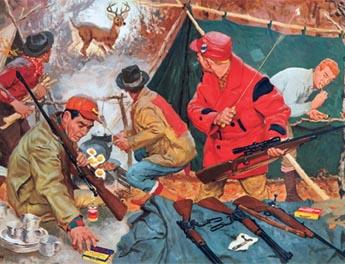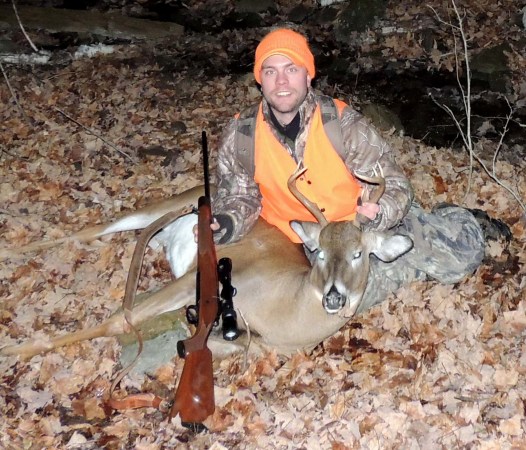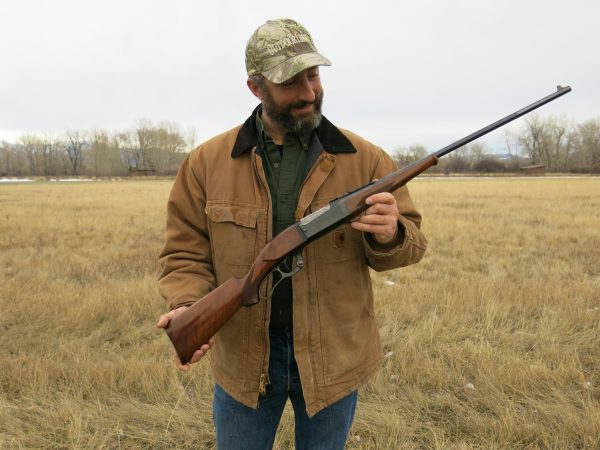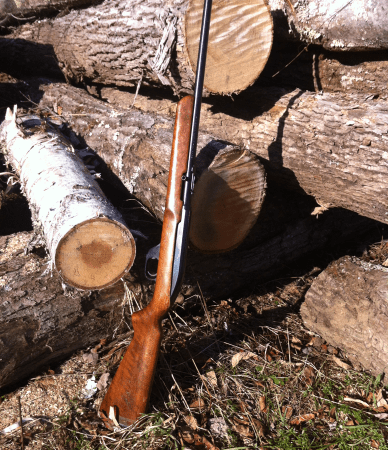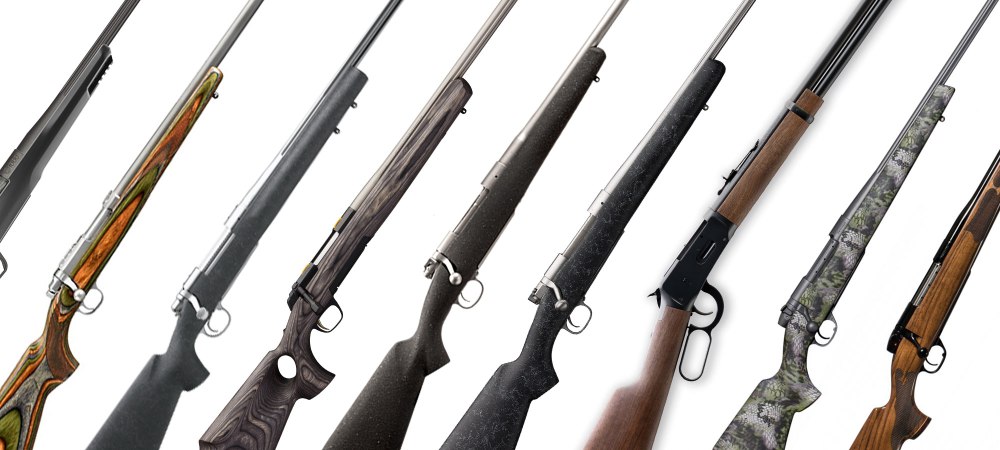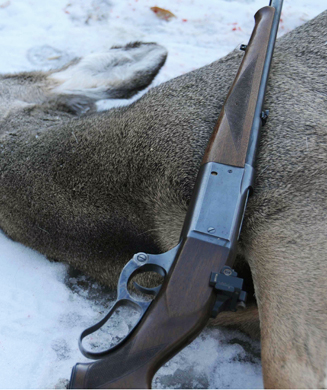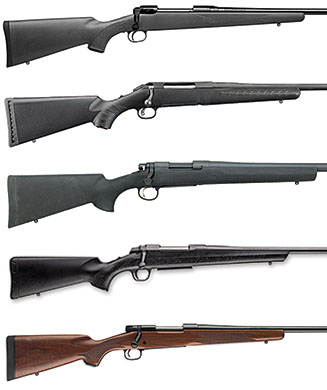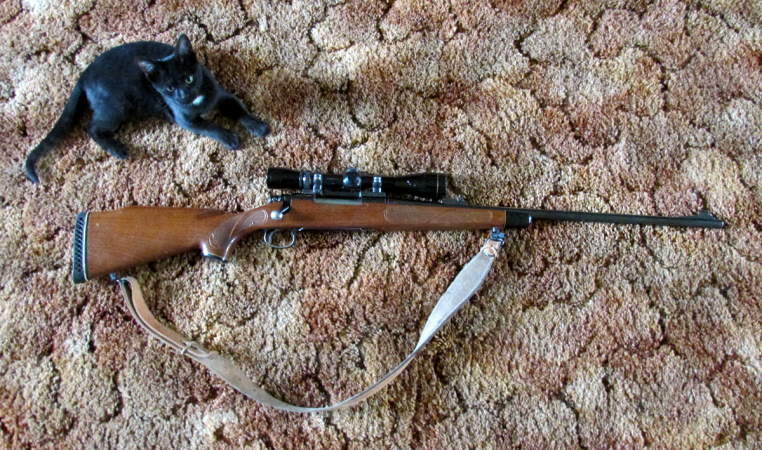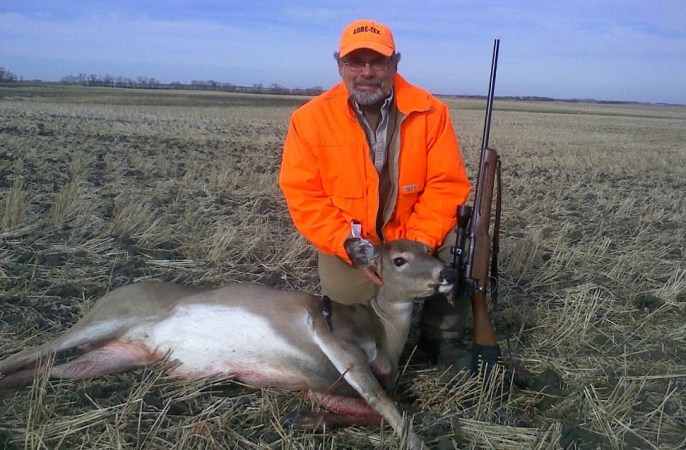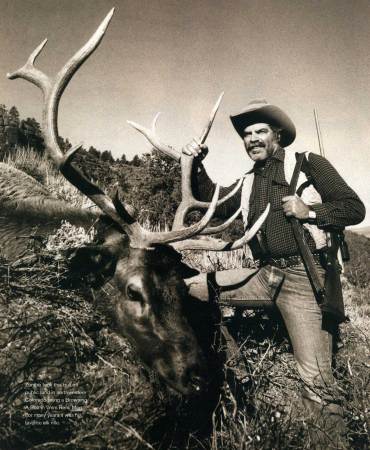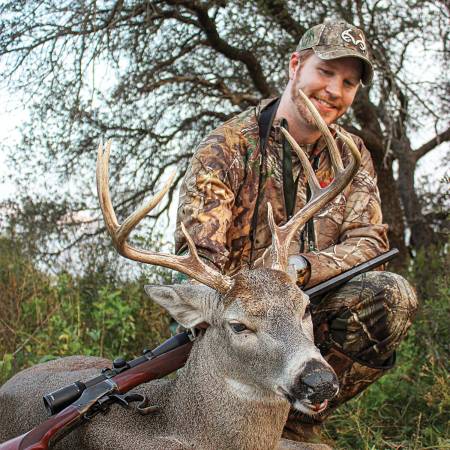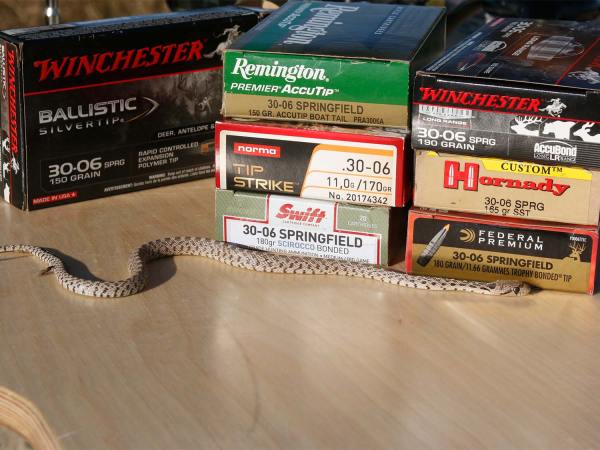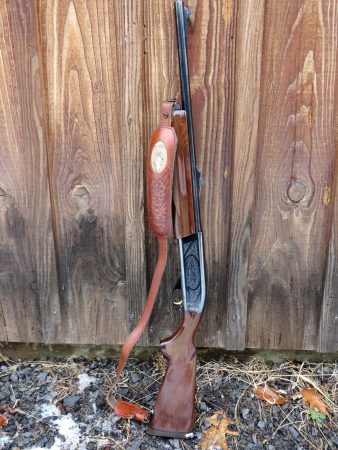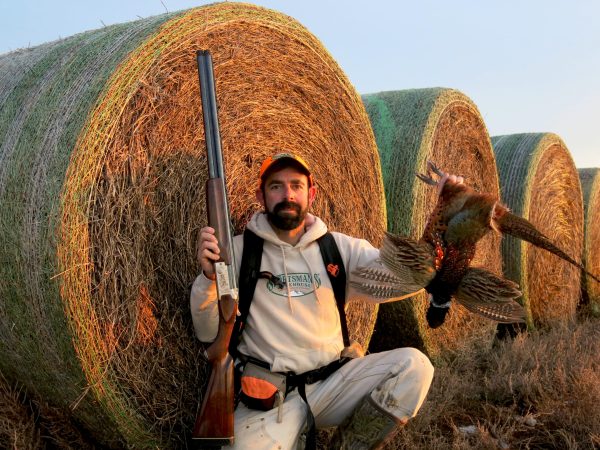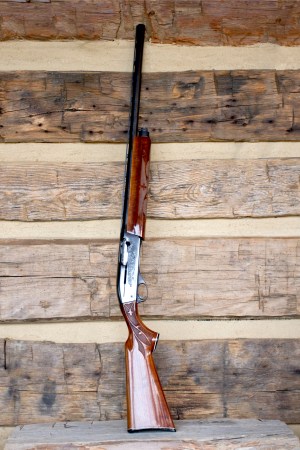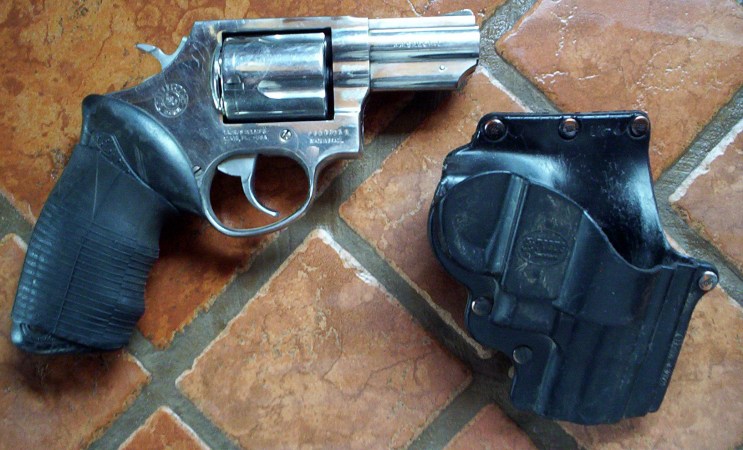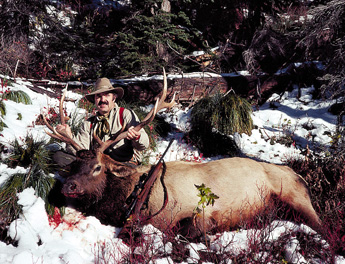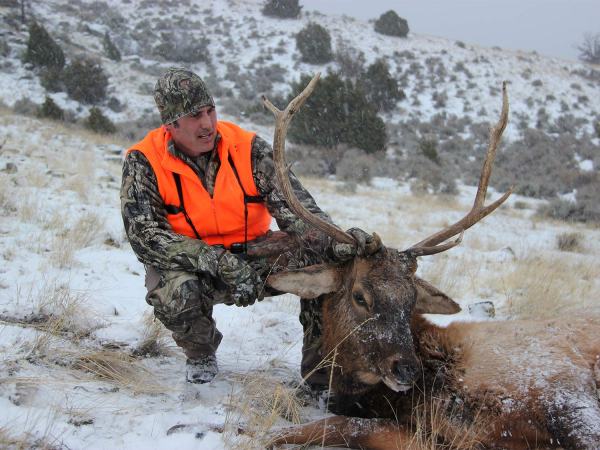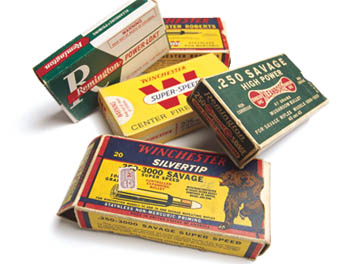We may earn revenue from the products available on this page and participate in affiliate programs. Learn More ›
I don’t have a favorite deer rifle, but I used to. It was a Model 94 Winchester that I got in a trade when I was 14. All the cowboys in the movies had lever-action Winchesters, so that was reason enough to want one. I can’t remember all the details of the deal, but the kid I swapped with drove a hard bargain. Among other valuable items he skinned me out of were a pocket watch that didn’t work and a model airplane engine that wouldn’t run.
The rifle was in pretty sad shape. It came with three cartridges, one of which I fired to make sure the gun would shoot. Actually, the rifle’s rusty metal and battered wood were among the reasons I wanted it. Even at that tender age I was a budding do-it-yourselfer and had visions of renewing the rifle to gleaming steel and glistening hand-rubbed wood.
What I mostly learned from that enterprise was that lever rifles are a lot trickier to reassemble than they are to take apart. When I finally got it back together it didn’t look much better than before and was certainly not what I had envisioned. But I had a deer rifle and it was my favorite, even though I never shot a deer with it.
The caliber of my deer rifle was .25/35 WCF, which we don’t hear much about these days. With a 117-grain bullet going 2,300 feet per second (fps), it was one of the first cartridges to be loaded with smokeless powder and was considered pretty hot stuff a century ago. Winchester still lists .25/35 ammo. I think I’ll buy a few boxes in case I ever get another rifle in that caliber.
Over the next couple of years I owned a succession of favorite deer rifles that I never shot a deer with. That was back when there were lots of military rifles around that ex-GI’s had brought home from the war. I bought them for $10 or so and restocked them with semi-finished stocks from Bishop or Fajen or Herters that cost about $6.95. Somehow my finished deer rifles never looked as good as those pictured in the stock catalogs, but they gradually improved. Not a day went by that I wasn’t slathering a layer of linseed oil on my latest hand-rubbed stock project.
First Loves
About that time I was starting to hang out with girls. Some of them asked why I always smelled so funny. (Apparently they didn’t know good linseed oil when they smelled it.) I also met a strange girl who turned up her nose when I opened a bottle of Hoppe’s No. 9. She was very pretty, but who would want to date a girl who doesn’t like a sniff of Hoppe’s now and then? It was also about then that I discovered that women aren’t necessarily burdened by common sense, so I began applying a Hoppe’s and linseed oil appreciation test to sort out the ones worth bothering with. Keepers were quite rare. But back to deer rifles.
Deer hunters love to argue about which caliber is best for deer. This is a very good thing, because if everyone agreed on the single best caliber, the world would be a dull place. Since that old .25/35 Winchester rifle I told you about earlier, I haven’t had a favorite deer caliber. Or, put another way, I’ve had about a half-dozen favorite deer calibers. Let’s talk about this for a moment.
Whitetail deer aren’t particularly tough to kill, but sometimes they are hard to hit. This simple fact is why some calibers are better than others, or at least why some calibers have earned reputations as great deer killers. A couple of calibers that come to mind are the old .250/3000 Savage and the .257 Roberts. Both of these are .25-caliber rifles. Depending on the ammo you use, they fire bullets in the 100- to 120-grain weight range at velocities of about 2,800 fps. This in turn yields a 100-yard energy of 1,500 foot-pounds, tops. By comparison, a factory-loaded .270 with a 130-grain bullet yields over 2,200 foot-pounds of energy at 100 yards.
But let’s not get bogged down in energy comparisons, because that isn’t the point. The point is: Why have some four generations of experienced hunters and writers singled out these two relatively small calibers in their recommendations of efficient deer killers? Does it mean there is some magic in the .25 caliber that makes it more deadly than, say, a .27 or a .30? Not a chance. Does it mean that .25’s are more accurate than other calibers? Not necessarily. Does it mean they are terrific “brush busters?” Get real, please. Does it mean that the average deer hunter is more likely to hit where he aims with a .25? Bingo! It’s as simple as that. Not only are these (and similar rounds) what we might call “user-friendly,” but they are also of a forgiving nature.
By “forgiving,” let’s say a hunter’s adrenaline starts pumping and he can’t, or doesn’t, bother to estimate whether his deer is 50 yards or 150 yards distant. It doesn’t matter, because if he’s sighted in at 100 yards the bullet is going to hit within an inch and a half of where he aims, which is plenty close. That’s forgiveness. If his rifle weighs 8 pounds with scope, the recoil is going to be a mild 9 foot-pounds or less. By comparison, an 8-pound .30/06 with 180-grain bullets will kick more than twice as hard. This “user-friendliness” is the main reason the .25’s have such a great reputation as deer killers. You shoot better with them.
Now this by no means implies that I’m advocating any .25-caliber as the best deer cartridge. In fact, of my half-dozen or so “favorite” whitetail rifles, only one is a quarter-bore. The others, except one, however, are also very forgiving.
Since I’ve already opened the Pandora’s box of “brush busting” cartridges, let’s discuss this much-discussed subject once more. I have a couple of rifles that are probably good brush busters. One is a .416 Rigby and the other a .458 Winchester Magnum. I suspect that steel-jacketed bullets from either of these rifles would not be much bothered by brush or even tree limbs as thick as your arm, but neither one of them makes my list of favorite deer rifles.
Brush Busters
When I hear hunters talking about brush-busting calibers, I often wonder what it is they’re shooting at. It seems to me that the whole point is to miss brush and similar obstructions rather than hit them. I’m simplifying, of course, but not by much, because we don’t hear about timber-busting calibers as much as we used to. One reason is that the myths about thumb-size bullets bulldozing their way through timber have pretty much been demolished. Another reason is the major changes in the way many of us hunt deer. Whereas still-hunting once predominated, hunters are now taking to tree stands in increasing numbers. Thus situated, a hunter fixes a number of possible lanes of fire calculated for a clear shot.
Occasionally I hunt from tree stands–Texas towers and blinds situated around bean fields. When I do I use rifles best suited for those conditions and shooting distances. They are not, however, my favorite deer rifles. Call me old-fashioned, but I still prefer still-hunting. It’s not because I see more deer that way, because I probably don’t, or that I find bigger bucks. But seeing deer isn’t the whole point of still-hunting; it’s seeing everything. When you’re stepping softly from tree to tree, stopping and looking with senses fine-tuned, one sees the world as the deer sees it. And the hour it may take to explore a dozen acres of woodland becomes a journey: Water gurgling under an ice-skimmed creek, deer tracks being filled by feathery flakes of snow and a perched grouse studying you with one eye and then the other become poetry in your journal at day’s end. A wool jacket, well-greased old boots and a favorite rifle become, like yourself, not invaders of nature but part of it.
The still-hunter and his quarry often recognize each other on instantly mutual terms. In one moment a deer so motionless it seems carved from stillness is bounding into flight, and there is only a heartbeat to aim and fire. This is the instant in which the much overused and misunderstood phrase “fast-handling” takes on honest meaning. I prefer the word “quick” to describe my favorite deer rifles because they are. Not just quick to shoulder, but quick on target–like pointing your finger. But there’s more to being a favorite rifle–whether it’s yours or mine–than just being deadly quick.
Personality Counts
Like a beloved book, an old hat or a longtime friend, being a favorite means something personal. This is why each of my favorite deer rifles, though they might share certain qualities, is appealing in an entirely different way. Perhaps this is best explained by one of my favorites, an old Model 64 Winchester. For one who is an affirmed user of bolt rifles and addicted to telescopic sights, the old lever-action, open-sighted Model 64 Winchester .30/30 seems oddly out of place on a list of favorites. It’s the personality thing, plus lots of nostalgia and class. According to the serial number, my 64 was made over a half-century ago. We don’t see many 64’s in the field these days because Winchester did not make many of them to begin with and collectors grab every one that comes up for sale. In case you’re not familiar with the M-64, just visualize the familiar M-94 Winchester in a Brooks Brothers suit and you’ll have the general idea.
Basically the 64 is a slicked-up 94 with a better trigger pull and pistol-grip stock. Back in 1950, when the 94 sold for $62.45, the basic 64 cost $82.95, which explains why so few were sold. My 64 is what they called the “Deer Rifle”–a deluxe grade with hand-checkering and other refinements. They sold for $97.75, which was pretty rich for the early 1950s and explains why there are so few around. But this is only part of the reason my slick 64 is a favorite.
Just picking it up and levering open the glassy-slick action evokes a gentler era of deer hunting–a time when there was no obsession with how a trophy scored and an eight-pointer was a “good’un.” Venison was valued more highly than antlers and a .30/30 was plenty enough gun. A hunt lasted a week, there were no phones and when a hunter went afield he did so on foot. A Model 64 Winchester was probably the slickest rifle in camp.
Another favorite in my rack is a Mannlicher-Schoenauer bolt rifle in 6.5×54 caliber. This mild-kicking cartridge is the classic caliber for the light Mannlicher carbine and there are few better rounds for deer. During its heyday, which was mainly between the two World Wars, the Austrian-made Mannlicher rifles earned a reputation for the unsurpassed smoothness of their actions and flawless feeding of the rotary magazine. Angle the muzzle upward, lift the distinctive “butterknife” bolt handle and the bolt glides rearward as if pulled by a ghostly hand. Yes, it is that slick.
Though Mannlichers were generally sold in upscale stores like Abercrombie & Fitch, they were not elitists’ rifles, but rather the choice of elite hunters. This is why so many of them found their way to Alaska and Africa. I picked up this favorite at a gun show years ago. The dealer I bought it from had no idea who the original owner was. The rifle itself, however, tells a lot about where it came from and what kind of hunter the first owner must have been. Almost certainly the rifle was purchased at Abercrombie & Fitch, since it bears identifying work by Griffin & Howe, its gunsmithing branch. The first owner was of a progressive mindset–he had the rifle equipped with a Lyman Alaskan scope, the most reliable scope of the 1930s, mounted in a Griffin & Howe quick-detachable mount. My guess is he was the type of hunter who wanted a solid backup in case the scope failed, because he also had the rifle fitted with a peep sight. This tells me he knew a good bit about shooting and anticipated shots at longer distances, with greater accuracy, than allowed by the Mannlicher’s folding-leaf open sights.
Very likely, the rifle was originally bought for a particular hunt and the combination of sights strongly indicates rugged hunting for distance targets, probably sheep, as it bears brutal evidence that it went to the mountain. The rifle also has the signature Griffin & Howe compass embedded in the stock and, most interesting of all, the length of pull has been shortened somewhat. So was the owner a man of shorter build or–a woman? Remember Hemingway’s “The Short Happy Life of Francis Macomber”? Poor Francis’s wife did him in with a 6.5 Mannlicher carbine just like mine! Perhaps this trim favorite has other secrets to tell.
A modern-day heir to the legendary 6.5×54 Mannlicher cartridge is the .260 Remington, and a spiritual heir to the Mannlicher carbine itself is a gorgeous Remington Model 7 rifle I had built by Remington’s Custom Shop. Like its spiritual godfather, my M-7 has the definitive full-length Mannlicher-type stock but is made of rigid, weather-resistant, laminated wood. The caliber, of course, is .260 Remington. When I first saw it, and felt it fly to my shoulder, it became an instant favorite. Set side by side in my gun rack, the older Mannlicher and its modern-day descendant are like father and son.
The favorite I’ve hunted with most often was built by legendary rifle maker Al Bieson. Built on a Mauser action much modified and beautified by Bieson, it is in the classic 7×57 Mauser caliber, which makes it a great all-purpose rifle for any game from whitetail to elk-sized African plains game. This is why it has been a companion piece for over two decades. I’ve written about this rifle before because of the marvelous Bieson stock contour, which makes the rifle point as quickly as an upland shotgun.
Whenever I whisk this Bieson masterpiece to my shoulder, I remember an afternoon nearing sunset in deep Texas when a big buck crashed out of the thorn into a narrow sendero about 160 yards ahead. He paused for an instant, spotted me and was turning to go back into the brush when my bullet caught him. It was one of those moments when time was so condensed that after the shot I couldn’t remember raising the rifle, pulling the trigger or hearing the gun go off. But I still have a vivid memory of the crosshairs on the buck as if they had got there by a will of their own. That’s the stuff of great deer rifles–and great memories.
Stories in Wood and Steel
If there is a favorite of my favorites, however, it has to be the .250/3000-caliber rifle that resulted from the combined talents of ace metalsmith Ron Lampert and stock maker Don Allen. One of the features that makes this rifle so special is the way Lampert took a standard-size M-98-style Mauser action and shortened it to a perfect length for the little .250 round. This is a tour de force of gunsmithing. Search as you will, it’s impossible to see where Lampert cut an inch out of the action and welded it back together.
Don Allen was an airline pilot back when the rifle was made, a student of fine gunmaking and making gunstocks as a hobby. That was over 30 years ago, when we were both pretty green and spent hours at a time discussing what a good hunting rifle should be. We wanted to put his thoughts into a deer rifle and the shortened Lampert action was a perfect place to start. The wood we found for the rifle is actually two species of walnut grown together. Experts tell me the blank was cut from where one species of walnut had been grafted onto another and they had grown together, making this rifle unique in several aspects, as well as being as near the perfect deer rifle as I ever hope to own.
Don Allen and his wife, Norma, as you may know, went on to found the Dakota Arms Company, maker of magnificently styled hunting rifles. Even as I was writing this article I learned that Don was suffering from an incurable ailment. He asked me, and a few other old-time buddies, to join him in South Dakota for what might be our last prairie dog hunt together. It was to be a bittersweet hunt, I reckoned, sweet with memories of great times we’d shared over the years, but I dreaded having to say goodbye to him for what might be the last time. A week before I was to leave for our hunt the call came. Don wouldn’t be there.
The rifle isn’t a sentimental favorite because of the passing of an old friend; it was already a favorite. But still, what is it that makes a favorite? A never-to-be-forgotten shot at twilight? The rifle that took the biggest deer you ever bagged? The rifle you always wanted as a kid? Or a rifle that makes you want to stop and pick it up every time you see it waiting in the rack? Waiting to go deer hunting.

